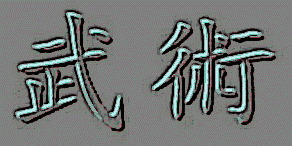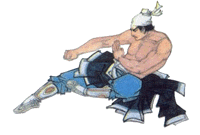

| Points
essentiels du Tongbiquan d'après Guo Chengyou (transmis par Guo Xianghe) |
English version Chinese version |
|
| Xu Yun | Gao Zhankui | Huang
Baoshan (en anglais) |
Gao Zhankui "Le
Faucon"![]()
Et la transmission du poing rouge.
À la 13ème
année de l'empereur de Kangxi, en 1674, le poing Rouge ou Hongquan
![]() fut créé
entre les provinces du Shandong et du Shaanxi. Le Hongquan a été
un système important pratiqué par les Han dans les cercles
des insurgés militaires contre l'occupant Mandchou pendant la dynastie
des Qing (1644-1911). La couleur rouge symbolisait la révolution
des Han contre les Manchous et aussi le soleil (le soleil est toujours
représenté rouge en Chine). Durant le milieu et la fin de
la dynastie de Qing la diffusion du poing Rouge et son développement
apporta une grande contribution au monde des arts martiaux chinois chez
des générations de maîtres célèbres.
Gao Zhankui
fut créé
entre les provinces du Shandong et du Shaanxi. Le Hongquan a été
un système important pratiqué par les Han dans les cercles
des insurgés militaires contre l'occupant Mandchou pendant la dynastie
des Qing (1644-1911). La couleur rouge symbolisait la révolution
des Han contre les Manchous et aussi le soleil (le soleil est toujours
représenté rouge en Chine). Durant le milieu et la fin de
la dynastie de Qing la diffusion du poing Rouge et son développement
apporta une grande contribution au monde des arts martiaux chinois chez
des générations de maîtres célèbres.
Gao Zhankui ![]() ,
un héros populaire du Shaanxi, aussi appelé Gao Chunming
,
un héros populaire du Shaanxi, aussi appelé Gao Chunming
![]() , était
connu sous le sobriquet de "Le faucon avec le les jambes volantes"
(feijiao yaozi
, était
connu sous le sobriquet de "Le faucon avec le les jambes volantes"
(feijiao yaozi ![]() )
en raison de sa rapidité avec ses pieds, ce qui en fut l'un des
maîtres le plus célèbre en Chine à la fin du
19ème siècle.
)
en raison de sa rapidité avec ses pieds, ce qui en fut l'un des
maîtres le plus célèbre en Chine à la fin du
19ème siècle.
Dans les "annales des arts martiaux du Shaanxi" et des "Annales
de Sanyuan", on y découvre l'importance de Gao Zhankui et
le mouvement rebelle du poing Rouge qui est ici très apparent dans
le développement des arts martiaux du Shaanxi. Pendant la guerre
de l'opium contre les Allemands, Gao Zhankui était un instructeur
militaire à Xi'an selon les "Annales de Gaoshan" (Gaoshan
shilue![]() ),
et il gagna une bataille à Wucheng avant qu'il n'ait été
décoré avec le titre de "guerrier courageux".
),
et il gagna une bataille à Wucheng avant qu'il n'ait été
décoré avec le titre de "guerrier courageux".
Trois généraux seigneurs de la guerre étaient connus
dans Shaanxi sous le nom des " trois hauts généraux
" durant le règne de Daoguan (1821-1851) ; Gao Zhankui dit
"Le faucon" (Yaozi ![]() ),
Xin san dit "le Tigre noir" (Heihu
),
Xin san dit "le Tigre noir" (Heihu ![]() )
et Su San, dit " le tigre affamé" (Ehu
)
et Su San, dit " le tigre affamé" (Ehu![]() ),
tous trois experts dans l'art du poing Rouge.
),
tous trois experts dans l'art du poing Rouge.
La province de Gansu était en guerre avec la province de Shaanxi
en 1863, et Gao Zhankui, le "faucon" fut actif durant la rébellion
Taiping des Boxeurs puis en escortant Shi Dakai au nord de la Chine pour
infiltrer l'ennemi.
Selon le "manuscrit Secret du poing de Shaolin" il est indiqué
que Gao Zhankui était habile dans la boxe du singe, et qu'il était
célèbre dans les provinces du Shaanxi et du Gansu.
Non seulement habile dans le poing Rouge, mais également dans la
boxe du singe (Houquan ![]() ),
les techniques de Gao Zhankui étaient d'un très haut niveau,
et il effectuait de nombreux sauts et saltos lors de ses combat, se battant
d'une manière très acrobatique. Il était même
dit qu'il possédait une technique secrète qui pouvait dévaster
son ennemi aussi rapidement qu'une tempête. Cette technique secrète
est mentionnée dans le "Manuscrit secret du poing de Shaolin"
avec Gao Zhankui comme celui qui la maîtrisait le mieux. La boxe
Rouge était enseignée dans les sociétés secrètes
durant la rébellion des boxeurs, Liu Yezhang et Liu Yezhang nous
indiquent que le signal employé pour les rebelles afin de s'identifier
étant la paume ouverte avec une main et l'autre main fermée
en poing, le poing touchant la paume intérieure de l'autre main.
),
les techniques de Gao Zhankui étaient d'un très haut niveau,
et il effectuait de nombreux sauts et saltos lors de ses combat, se battant
d'une manière très acrobatique. Il était même
dit qu'il possédait une technique secrète qui pouvait dévaster
son ennemi aussi rapidement qu'une tempête. Cette technique secrète
est mentionnée dans le "Manuscrit secret du poing de Shaolin"
avec Gao Zhankui comme celui qui la maîtrisait le mieux. La boxe
Rouge était enseignée dans les sociétés secrètes
durant la rébellion des boxeurs, Liu Yezhang et Liu Yezhang nous
indiquent que le signal employé pour les rebelles afin de s'identifier
étant la paume ouverte avec une main et l'autre main fermée
en poing, le poing touchant la paume intérieure de l'autre main.
Gao Zhankui enseignait le poing rouge aux insurgés et gardait la
boxe de singe pour lui même; il devait avoir eu cinq formes de boxe
de singe; la grande forme de la boxe de singe, la petite forme de la boxe
de singe, la grande forme du bâton du singe, la petite forme du
bâton du singe, et le bâton ivre du singe.
Huang Baoshan a rencontré Gao Zhankui au début du 20ème
siècle, et il le pria d'étudier avec lui avant qu'il ne
soit accepté en devenant l'un de ses meilleur disciple ; il étudia
la technique secrète de "la femme qui regarde le miroir"
(Meinü zhaojing ![]() )
et le système complet de la boxe du poing Rouge.
)
et le système complet de la boxe du poing Rouge.
Avant 1928, les moines du monastère de Shaolin pratiquaient le
Hongquan des trois généraux du Shaanxi, mais après
la reconstruction du temple et de la sortie du film Shaolin si dans les
années huitante, des formes au même nom, mais de création
moderne furent établies au fameux monastère.
Le Shaolin était un centre ou de nombreux maîtres d'arts
martiaux se rencontraient et transmettaient leurs savoirs aux moines qui
perpétuaient leur pratique au sein de la communauté monastique
à des fins militaires. La période anti-Mandchoue et les
guerres de l'Opium en firent un lieu privilégié pour l'apprentissage
des arts martiaux comme par le passé.
Deux formes principales du poing rouge étaient enseignées
aux moines, le "grand poing rouge" (Shaolinda hongquan ![]() )et
le "petit poing Rouge" (Shaolinxiao hongquan
)et
le "petit poing Rouge" (Shaolinxiao hongquan ![]() ).
Le poing rouge est un long système de poing (Changquan
).
Le poing rouge est un long système de poing (Changquan ![]() ),
les bras sont collés au corps au niveau des épaules pour
se protéger, les mouvements sont grands et amples utilisant le
poing, la paume, le crochet dans les positions de base Mabu, gongbu et
xubu.
),
les bras sont collés au corps au niveau des épaules pour
se protéger, les mouvements sont grands et amples utilisant le
poing, la paume, le crochet dans les positions de base Mabu, gongbu et
xubu.
La forme de base enseignée était celle des "Deux routes
du poing rouge" (erluhongquan ![]() )
effectuée sur un diagramme en losange, utilisant le coup de pied
arrière et de nombreux poings de base de ce système rapide
dans l'utilisation en combat.
)
effectuée sur un diagramme en losange, utilisant le coup de pied
arrière et de nombreux poings de base de ce système rapide
dans l'utilisation en combat.
Aujourd'hui, le Hongquan est disséminé dans de nombreuses
provinces du nord de la Chine, comme le Shandong, le Shaanxi, le Gansu,
le Xinjiang, Ningxia etc.
-Détails transmis à Lucas Christopoulos par Huang Baoshan, disciple de Gao Zhankui "Le faucon" à Tianshui, Gansu en 1993.
Gao
Zhankui ![]() "The
hawk"
"The
hawk"
And the transmission of Red fist boxing
At the 13th year of
the Kangxi emperor reign in 1674, the Red fist or Hongquan ![]() has
been created between the provinces of Shandong and Shaanxi. Since that
time Hongquan has been a major system practiced by the local Han from
the circles of military insurgents against the Manchu occupation during
the Qing Dynasty (1644-1911). The red colour was symbolising the Han revolutionaries
against the Manchu as well as the sun (the sun is always represented red
in China). During the middle and late part of the Qing Dynasty the Red
fist (Hongquan
has
been created between the provinces of Shandong and Shaanxi. Since that
time Hongquan has been a major system practiced by the local Han from
the circles of military insurgents against the Manchu occupation during
the Qing Dynasty (1644-1911). The red colour was symbolising the Han revolutionaries
against the Manchu as well as the sun (the sun is always represented red
in China). During the middle and late part of the Qing Dynasty the Red
fist (Hongquan ![]() )
development dissemination to the Chinese martial arts world made a big
contribution in generation of masters in Shaanxi. Master Gao Zhankui (
)
development dissemination to the Chinese martial arts world made a big
contribution in generation of masters in Shaanxi. Master Gao Zhankui (![]() ,
or Gao Chunming
,
or Gao Chunming ![]() ),
also named "Gao the hawk with flying legs" (feijiao yaozi
),
also named "Gao the hawk with flying legs" (feijiao yaozi ![]() ),because
of his fastness with his foots is one of the most famous master in China
during this troubled times of the end of the 19th century.
),because
of his fastness with his foots is one of the most famous master in China
during this troubled times of the end of the 19th century.
According to the "Shaanxi martial arts records" and the "Sanyuan
county annals" the importance of Gao Zhankui and the Red fist movement
is very noticeable in the development of Chinese martial arts of Shaanxi.
During the opium war against the Germans, Gao Zhankui was a military instructor
in Xi'an according to the "records from Gaoshan "( Gaoshan shilue
![]() ) and he
wined a battle war at Wucheng before he was quoted as "brave warrior".
) and he
wined a battle war at Wucheng before he was quoted as "brave warrior".
They where three warlords generals in Shaanxi known as the three high
generals (Gaosan ![]() )
in the Daoguan Reign (1821-1851); Gao san "the hawk"(Yaozi
)
in the Daoguan Reign (1821-1851); Gao san "the hawk"(Yaozi ![]() ),
Xin San "the black tiger" (Heihu
),
Xin San "the black tiger" (Heihu ![]() ),
and Su San "the angry tiger"(Ehu
),
and Su San "the angry tiger"(Ehu ![]() )
all experts in Hongquan.
)
all experts in Hongquan.
The Gansu province was in war with the Shaanxi province in 1863, and Gao
Zhankui, the "hawk" then had take an active part during the
Heavenly Taiping Kingdom rebellion by escorting Shi Dakai to the north
of China and to infiltrate the enemy's.
According to the "Secret manuscript of the Shaolin Boxing",
it his saying that Gao Zhankui was skilled in the monkey boxing (Houquan
![]() ), famous in Shaanxi
and in Gansu.
), famous in Shaanxi
and in Gansu.
Not only skilled in the Red fist, but also in Monkey boxing, the techniques
of Gao Zhankui where very skilful, and he was able to make a lot of jumping
kicks, splits in fighting and even it is said that he had a secret technique
that could devastate the enemy once like the thunderstorm. This secret
technique is mentioned in the "Manuscript of the Shaolin Boxing"
as Gao a great master of it. The Red style boxing still was teach in secret
societies during the Taiping Boxing rebellion, Liu Yezhang and Liu Yezhang
indicate us that the signal used for the rebels to recognise each other
was the open palm with one hand and the fist close with the other hand,
the fist touching the inside palm.
Gao Zhankui was teaching Red fist to the insurgents and kept most of his
Monkey boxing for himself; there must have been five sets of Monkey boxing,
the big from of monkey boxing, the small form of monkey boxing, the big
form of monkey stick, the small form monkey stick, and the drunken monkey
stick.
Huang Baoshan met Gao Zhankui in the beginning of the 20th century, and
beg him to studying with him before he could be accepted as one of his
best disciple, he could so study the secret technique of the "beautiful
women look at the mirror" (Meinu zhaojing ![]() )
and train it together with the complete system of Red fist boxing.
)
and train it together with the complete system of Red fist boxing.
Before 1928, the monks of the Shaolin monastery where used to practice
the Hongquan of the "San Gao" generals transmitted by them or
they're students at the temple, but after the reconstruction following
the movie "Shaolin Temple" (Shaolin si ![]() )
in the 80th , those Hongquan forms have the same name but are different
in application because they are a modern creation from the Sports Circles.
)
in the 80th , those Hongquan forms have the same name but are different
in application because they are a modern creation from the Sports Circles.
We don't have to see the Shaolin temple as a centre where wushu grows
like flowers in a pot coming from nowhere. It was a centre where famous
masters passed by and teach they're skills to the monks that practiced
then in the monastery as military purpose, especially during the anti
Manchu uprisings and the troubled times of the opium wars. The Red fist
was usually known in Shaolin within two sets, the Shaolin little red fist
(Shaolinxiao hongquan ![]() )
and the Shaolin big red fist (Shaolinda hongquan
)
and the Shaolin big red fist (Shaolinda hongquan ![]() ),
and those forms where imported to Shaolin by the anti Manchu societies
that where developed outside of the temple.
),
and those forms where imported to Shaolin by the anti Manchu societies
that where developed outside of the temple.
In the original system of Hongquan, the movements are long, and it is
to put in the long range boxing (Changquan ![]() ),
the "two roads Red fist" (erluhongquan
),
the "two roads Red fist" (erluhongquan ![]() ?),
was a basic routine teach in the beginning . At the Shaolin temple today,
the moves are cut and shorts, unlike the original Red fist, that is fluid
with long movements of the arms.
?),
was a basic routine teach in the beginning . At the Shaolin temple today,
the moves are cut and shorts, unlike the original Red fist, that is fluid
with long movements of the arms.
Today we practice the original Hongquan transmitted directly from Gao
Zhangkui from Shaanxi province and Huang Baoshan from Gansu province.
Red fist is wildly disseminate in all the north of provinces of China
today, especially in Shaanxi, Shandong, Gansu, Ningxia, Xinjiang etc.
-Records transmitted
to Lucas Christopoulos by Huang Baoshan, disciple of Gao Zhankui "The
hawk", in 1993 at the town of Tianshui, Gansu province.
